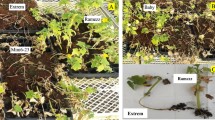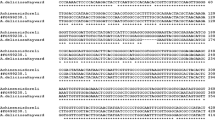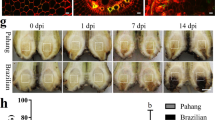Abstract
Pseudomonas chlororaphis ToZa7 is a promising biocontrol agent possessing valuable characteristics and reducing disease severity caused by Fusarium oxysporum f. sp. radicis-lycopersici (Forl) in tomato. In this study, the strain’s ability to induce three pathogenesis-related (PR) genes (PR-1a, GLUA, and CHI3) in tomato, was studied using quantitative reverse transcription PCR. The genes PR-1a and GLUA were up-regulated after 120 h exposure to P. chororaphis ToZa7 (15.22- and 13.11-fold, respectively), as compared to the untreated control, without challenge inoculation by the pathogen. To study the effects of individual or combined application of P. chororaphis ToZa7 and the compatible biocontrol fungus Clonostachys rosea IK726, challenged with the pathogen, the expression patterns of the above three PR genes were monitored, in tomato roots. Expression of PR1-a was noteworthy, especially 48 h after challenge inoculation, when C. rosea IK726 alone or in combination with P. chororaphis, ToZa7 was pre-inoculated on tomato roots (38.53-fold and 53.74-fold, respectively). Expression of PR1-a, 72 h after challenge inoculation, was the highest in P. chororaphis ToZa7, among biocontrol treatments. Expression of CHI3 was much lower, while up-regulation of GLUA was overall not observed. Confocal laser scanning microscopy of intact tomato roots and bacterial counts of superficially disinfected roots revealed, for the first time, that P. chororaphis ToZa7 colonizes the exterior as well as the internal tissues.




Similar content being viewed by others
Explore related subjects
Discover the latest articles and news from researchers in related subjects, suggested using machine learning.References
Aimé S, Alabouvette C, Steinberg C, Olivain C (2013) The endophytic strain Fusarium oxysporum Fo47: a good candidate for priming the defense responses in tomato roots. Mol Plant Microbe Interact 26(8):918–926. https://doi.org/10.1094/MPMI-12-12-0290-R
Alonso-Ramírez A, Poveda J, Martín I, Hermosa R, Monte E, Nicolás C (2014) Salicylic acid prevents Trichoderma harzianum from entering the vascular system of roots. Mol Plant Path 15(8):823–831. https://doi.org/10.1111/mpp.12141
Barea JM, Pozo MJ, Azco R, Azco-Aguilar C (2005) Microbial co-operation in the rhizosphere. J Exp Bot 56(417):1761–1778. https://doi.org/10.1093/jxb/eri197
Bertani G (1951) Studies on lysogenesis. The mode of phage liberation by lysogenic Escherichia coli. J Bacteriol 62:293–300
Bolwerk A, Lagopodi AL, Wijfjes AH, Lamers GE, Chin-A-Woeng TF, Lugtenberg BJ, Bloemberg GV (2003) Interactions in the tomato rhizosphere of two Pseudomonas biocontrol strains with the phytopathogenic fungus Fusarium oxysporum f. sp. radicis-lycopersici. Mol Plant Microbe Interact 16(11):983–993. https://doi.org/10.1094/MPMI.2003.16.11.983
Chatterton S, Jayaraman J, Punja ZK (2008) Colonization of cucumber plants by the biocontrol fungus Clonostachys rosea f. sp. catenulata. Biol Control 46(2):267–278. https://doi.org/10.1016/j.biocontrol.2008.02.007
Compant S, Duffy B, Nowak J, Clement C, Barka E (2005a) Use of plant growth promoting bacteria for biocontrol of plant diseases: principles, mechanisms of action and future prospects. Appl Environ Microbiol 71(9):4951–4959. https://doi.org/10.1128/AEM.71.9.4951-4959.2005
Compant S, Reiter B, Sessitsch A, Nowak J, Clément C, Ait Barka E (2005b) Endophytic colonization of Vitis vinifera L. by plant growth-promoting bacterium Burkholderia sp. strain PsJN. Appl Environ Microbiol 71:1685–1693. https://doi.org/10.1128/AEM.71.4.1685-1693.2005
De Meyer G, Audenaert K, Höfte M (1999) Pseudomonas aeruginosa 7NSK2-induced systemic resistance in tobacco depends on in planta salicylic acid accumulation but is not associated with PR1-a expression. Eur J Plant Pathol 105:513–517. https://doi.org/10.1023/A:1008741015912
Devi Khaidem A, Pandey G, Rawat AKS, Sharma Gauri D, Pandey P (2017) The endophytic symbiont Pseudomonas aeruginosa stimulates the antioxidant activity and growth of Achyranthes aspera L. Front Microbiol 8:1897–1911. https://doi.org/10.3389/fmicb.2017.01897
Duffy BK, Simon A, Weller DM (1996) Combination of Trichoderma koningii with fluorescent pseudomonads for control of take-all on wheat. Phytopathology 86:188–194. https://doi.org/10.1094/Phyto-86-188
Harel YM, Mehari ZH, Rav-David D, Elad Y (2014) Systemic resistance to gray mold induced in tomato by benzothiadiazole and Trichoderma harzianum T39. Phytopathology 104(2):150–157. https://doi.org/10.1094/PHYTO-02-13-0043-R
He CY, Wolyn DJ (2005) Potential role for salicylic acid in induced resistance of asparagus roots to Fusarium oxysporum f. sp. asparagi. Plant Pathol 54:227–232. https://doi.org/10.1111/j.1365-3059.2005.01163.x
Iavicoli A, Boutet E, Buchala A, Metraux JP (2003) Induced systemic resistance in Arabidopsis thaliana in response to root inoculation with Pseudomonas fluorescens CHA0. Mol Plant Microbe Interact 16(10):851–858. https://doi.org/10.1094/MPMI.2003.16.10.851
Jensen B, Knudsen IMB, Jensen DF (2000) Biological seed treatment of cereals with fresh and long-term stored formulations of Clonostachys rosea: biocontrol efficacy against Fusarium culmorum. Eur J Plant Pathol 106:233–242. https://doi.org/10.1023/A:1008794626600
Jensen DF, Knudsen IMB, Lόbeck M, Mamarabadi M, Hockenhull J, Jensen B (2007) Development of a biocontrol agent for plant disease control with special emphasis on the near commercial fungal antagonist Clonostachys rosea strain IK726. Aust Plant Pathol 36:95–101. https://doi.org/10.1071/AP07009
Jones DL, Nguyen C, Finlay RD (2009) Carbon flow in the rhizosphere: carbon trading at the soil–root interface. Plant Soil 321:5–33. https://doi.org/10.1007/s11104-009-9925-0
Kamou NN, Karasali H, Menexes G, Kasiotis KM, Bon MC, Papadakis EN, Tzelepis GD, Lotos L, Lagopodi A (2015) Isolation screening and characterization of local beneficial rhizobacteria based upon their ability to suppress the growth of Fusarium oxysporum f. sp. radicis-lycopersici and tomato foot and root rot. Biocontrol Sci Technol 25(8):928–949. https://doi.org/10.1080/09583157.2015.1020762
Kamou NN, Dubey M, Tzelepis G, Menexes G, Papadakis EN, Karlsson M, Lagopodi AL, Jensen DF (2016) Investigating the compatibility of the biocontrol agent Clonostachys rosea IK726 with prodigiosin-producing Serratia rubidaea S55 and phenazine-producing Pseudomonas chlororaphis ToZa7. Arch Microbiol 198:369–377. https://doi.org/10.1007/s00203-016-1198-4
Karlsson M, Durling MB, Choi J, Kosawang C, Lackner G, Tzelepis GD, Nygren K, Dubey MK, Kamou N, Levasseur A, Zapparata A, Wang J, Amby DB, Jensen B, Sarrocco S, Panteris E, Lagopodi AL, Püggeler S, Vannacci G, Collinge DB, Hoffmeister D, Henrissat B, Lee YH, Jensen DF (2015) Insights on the evolution of mycoparasitism from the genome of Clonostachys rosea. Genome Biol Evol 7(2):465–480. https://doi.org/10.1093/gbe/evu292
Kavroulakis N, Papadopoulou KK, Ntougias S, Zervakis GI, Ehaliotis C (2006) Cytological and other aspects of pathogenesis related gene expression in tomato plants grown on a suppressive compost. Ann Bot 98:555–564. https://doi.org/10.1093/aob/mcl149
Lagopodi AL, Ram AFJ, Gerda EM, Lamers GEM, Punt PJ, Van den Hondel CAMJJ, Bloemberg GV (2002) Novel aspects of tomato root colonization and infection by Fusarium oxysporum f. sp. radicis-lycopersici revealed by confocal laser scanning microscopic analysis using the green fluorescent protein as a marker. Mol Plant Microbe Interact 15:172–179. https://doi.org/10.1094/MPMI.2002.15.2.172
Lahlali R, Peng G (2013) Suppression of clubroot by Clonostachys rosea via antibiosis and induced host resistance. Plant Pathol 63(2):447–455. https://doi.org/10.1111/ppa.12112
Lambertsen L, Sternberg C, Molin S (2004) Mini-Tn7 transposons for site- specific tagging of bacteria with fluorescent proteins. Environ Microbiol 6:726–732. https://doi.org/10.1111/j.1462-2920.2004.00605.x
Li GQ, Huang HC, Acharya SN, Erickson RS (2004) Biological control of blossom blight of alfalfa caused by Botrytis cinereal under environmentally controlled and field conditions. Plant Dis 88:1246–1251. https://doi.org/10.1094/PDIS.2004.88.11.1246
Li Y, Gu Y, Li J, Xu M, Wei Q, Wang Y (2015) Biocontrol agent Bacillus amyloliquefaciens LJ02 induces systemic resistance against cucurbits powdery mildew. Front Microbiol 6:883. https://doi.org/10.3389/fmicb.2015.00883
Livak KJ, Schmittgen TD (2001) Analysis of relative gene expression data using real-time quantitative PCR and the 2−ΔΔCT method. Methods 25:402–408. https://doi.org/10.1006/meth.2001.1262
Lugtenberg BJ, Kamilova F (2009) Plant growth promotion rhizobacteria. Annu Rev Microbiol 63:541–556. https://doi.org/10.1146/annurev.micro.62.081307.162918
Luongo L, Galli M, Corazza L, Meekes E, De Haas L, Van Der Plas CL, Køhl J (2005) Potential of fungal antagonists for biocontrol of Fusarium spp. in wheat and maize through competition in crop debris. Biocontrol Sci Technol 15(3):229–242. https://doi.org/10.1080/09583150400016852
Mercado-Blanco J, Bakker PAHM (2007) Interactions between plants and beneficial Pseudomonas spp.: exploiting bacterial traits for crop protection. Antonie Van Leeuwenhoek 92:367–389. https://doi.org/10.1007/s10482-007-9167-1
Mercado-Blanco J, Prieto P (2013) Endophytic lifestyle of biocontrol strains of Pseudomonas spp. in olive roots. In: de Bruijn FJ (ed) Molecular microbial ecology of the rhizosphere and chapter 2, vol 1. Wiley, Hoboken. https://doi.org/10.1002/9781118297674.ch90
Paparu P, Dubois T, Coyne D, Viljoen A (2007) Defense-related gene expression in susceptible and tolerant bananas (Musa spp.) following inoculation with non-pathogenic Fusarium oxysporum endophytes and challenge with Radopholus similis. Physiol Mol Plant Pathol 71:149–157. https://doi.org/10.1016/j.pmpp.2007.12.001
Papayiannis LC, Harkou IS, Markou YM, Demetriou CN, Katis NI (2011) Rapid discrimination of Tomato chlorosis virus, Tomato infectious chlorosis virus and co-amplification of plant internal control using real-time RT-PCR. J Virol Methods. https://doi.org/10.1016/j.jviromet.2011.05.036
Pappi PG, Chaintoutis SC, Dovas CI, Efthimiou KE, Katis NI (2015) Development of one-tube real-time qRT-PCR and evaluation of RNA extraction methods for the detection of Eggplant mottled dwarf virus in different species. J Virol Methods 212:59–65. https://doi.org/10.1016/j.jviromet.2014.11.001
Pieterse CM, van Wees SC, Hoffland E, van Pelt JA, van Loon LC (1996) Systemic resistance in Arabidopsis induced by biocontrol bacteria is independent of salicylic acid accumulation and pathogenesis-related gene expression. Plant Cell 8(8):1225–1237. https://doi.org/10.2307/3870297
Pieterse CMJ, Van Pelt JA, Ton J, Parchmann S, Mueller MJ, Antony Buchalac AJ, Métraux JP, Van Loon CL (2000) Rhizobacteria mediated induced systemic resistance (ISR) in Arabidopsis requires sensitivity to jasmonate and ethylene but is not accompanied by an increase in their production. Physiol Mol Plant Pathol 57:123–134. https://doi.org/10.1006/pmpp.2000.0291
Pieterse CMJ, Van Der Does D, Zamioudis C, Leon-Reyes A, Van Wees SCM (2012) Hormonal modulation of plant immunity. Annu Rev Cell Dev Biol 28:489–521. https://doi.org/10.1146/annurev-cellbio-092910-154055
Roberti R, Veronesi AR, Cesari A, Cascone A, Di Berardina I, Bertini L, Caruso C (2008) Induction of PR proteins and resistance by the biocontrol agent Clonostachys rosea in wheat plants infected with Fusarium culmorum. Plant Sci 175(3):339–347. https://doi.org/10.1016/j.plantsci.2008.05.003
Robert-Seilaniantz A, Grant M, Jones JD (2011) Hormone crosstalk in plant disease and defense: more than just jasmonate-salicylate antagonism. Annu Rev Phytopathol 49:317–343. https://doi.org/10.1146/annurev-phyto-073009-114447
Rosenblueth M, Martínez-Romero E (2006) Bacterial endophytes and their interactions with hosts. Mol Plant Microbe Interact 19:827–837. https://doi.org/10.1094/MPMI-19-0827
Salas-Marina MA, Silva-Flores MA, Uresti-Rivera EE, Castro-Longoria E, Herrera-Estrella A, Casas-Flores S (2011) Colonization of Arabidopsis roots by Trichoderma atroviride promotes growth and enhances systemic disease resistance through jasmonic acid/ethylene and salicylic acid pathways. Eur J Plant Pathol 131(1):15–26. https://doi.org/10.1007/s10658-011-9782-6
Shoresh M, Yedidia I, Chet I (2005) Involvement of jasmonic acid/ethylene signalling pathway in the systemic resistance induced in cucumber by Trichoderma asperellum T203. Phytopathol 95:76–84. https://doi.org/10.1094/PHYTO-95-0076
Simons M, van der Bij AJ, Brand I, de Weger LA, Wijffelman CA, Lugtenberg BJJ (1996) Gnotobiotic system for studying rhizosphere colonization by plant growth-promoting Pseudomonas rhizobacteria. Mol Plant Microbe Interact 9:600–607. https://doi.org/10.1094/MPMI-9-0600
Srivastava R, Khalid A, Singh US, Sharma AK (2010) Evaluation of arbuscular mycorrhizal fungus, fluorescent Pseudomonas and Trichoderma harzianum formulation against Fusarium oxysporum f. sp. lycopersici for the management of tomato wilt. Biol Control 53:24–31. https://doi.org/10.1016/j.soilbio.2015.04.001
Sturz AV, Christie BR, Nowak J (2000) Bacterial endophytes: potential role in developing sustainable systems of crop production. Crit Rev Plant Sci 19:1–30. https://doi.org/10.1016/S0735-2689(01)80001-0
Timmusk S, Wagner EG (1999) The plant-growth-promoting rhizobacterium Paenibacillus polymyxa induces changes in Arabidopsis thaliana gene expression: a possible connection between biotic and abiotic stress responses. Mol Plant Microbe Interact 12(11):951–959. https://doi.org/10.1094/MPMI.1999.12.11.951
Trdá L, Boutrot F, Claverie J, Brulé D, Dorey S, Poinssot B (2015) Perception of pathogenic or beneficial bacteria and their evasion of host immunity: pattern recognition receptors in the frontline. Front Plant Sci 6:219. https://doi.org/10.3389/fpls.2015.00219
Tucci M, Ruocco M, De Masi L, De Palma M, Lorito M (2011) The beneficial effect of Trichoderma spp. on tomato is modulated by the plant genotype. Mol Plant Pathol 12(4):341–354. https://doi.org/10.1111/j.1364-3703.2010.00674.x
Tzelepis GD, Lagopodi AL (2011) Interactions between Clonostachys rosea IK726 and Pseudomonas chlororaphis PCL1391 against tomato foot and root rot caused by Fusarium oxysporum f. sp. radicis-lycopersici. Multitrop Interact Soil IOBC/WPRS Bull 63:75–79
Van Wees SCM, Pieterse CMJ, Trijssenaar A, Van Westend YAM, Hartog F, Van Loon LC (1997) Differential induction of systemic resistance in Arabidopsis by biocontrol bacteria. Mol Plant Microbe Interact 10:716–724. https://doi.org/10.1094/MPMI.1997.10.6.716
Veloso J, Diaz J (2012) Fusarium oxysporum Fo47 confers protection to pepper plants against Verticillium dahliae and Phytophthora capsici, and induces the expression of defense genes. Plant Pathol 61:281–288. https://doi.org/10.1111/j.1365-3059.2011.02516.x
Verhagen BWM, Glazebrook J, Zhu T, Chang HS, Van Loon LC, Pieterse CMJ (2004) The trancriptome of the rhizobacteria-induced systemic resistance in Arabidopsis. Mol Plant Microbe Interact 17:895–908. https://doi.org/10.1094/MPMI.2004.17.8.895
Weller D (2007) Pseudomonas biocontrol agents of soilborne pathogens: looking back over 30 years. Phytopathology 97:250–256. https://doi.org/10.1094/PHYTO-97-2-0250
Yedidia I, Shoresh M, Kerem Z, Benhamou N, Kapulnik Y, Chet I (2003) Concomitant induction of systemic resistance to Pseudomonas syringae pv. lachrymans in cucumber by Trichoderma asperellum (T-203) and accumulation of phytoalexins. Appl Environ Microbiol 69(12):7343–7353 (PMCID: PMC309998)
Zamioudis C, Pieterse CM (2012) Modulation of host immunity by beneficial microbes. Mol Plant Microbe Interact 25:139–150. https://doi.org/10.1094/MPMI-06-11-0179
Zipfel C (2014) Plant pattern-recognition receptors. Trends Immunol 35:345–351. https://doi.org/10.1016/j.it.2014.05.004
Acknowledgements
Authors would like to thank Professor Søren Molin and Dr. Lotte Lambertsen (Technical University of Denmark), and Professor Cayo Ramos (Universidad de Málaga), for kindly supplying the strains and methodology to transform with the mini-Tn7-gfp. Authors are also grateful to professors D.F. Jensen (Swedish University of Agricultural Sciences, Sweden; SLU) and B.J.J. Lugtenberg (Leiden University, The Netherlands for providing strains Clonostachys rosea IK726, and Fusarium oxysporum f. sp. radicis-lycopersici ZUM 2407 (IPO-DLO), respectively. This work was partially supported by Plan Nacional I + D + I from Ministerio de Economía (MINECO; AGL14-52518-C2-1-R), co-financed by FEDER funds (EU). We are also grateful to José A. Gutierrez, Carmen Vida, Sandra Tienda, and David Navas Fernandez for assistance with bacterial transformation and microscopy.
Author information
Authors and Affiliations
Corresponding author
Ethics declarations
Conflict of interest
All authors declare that they have no conflict of interest.
Additional information
Communicated by Erko Stackebrandt.
Publisher's Note
Springer Nature remains neutral with regard to jurisdictional claims in published maps and institutional affiliations.
Electronic supplementary material
Below is the link to the electronic supplementary material.
Rights and permissions
About this article
Cite this article
Kamou, N.N., Cazorla, F., Kandylas, G. et al. Induction of defense-related genes in tomato plants after treatments with the biocontrol agents Pseudomonas chlororaphis ToZa7 and Clonostachys rosea IK726. Arch Microbiol 202, 257–267 (2020). https://doi.org/10.1007/s00203-019-01739-4
Received:
Revised:
Accepted:
Published:
Issue Date:
DOI: https://doi.org/10.1007/s00203-019-01739-4




